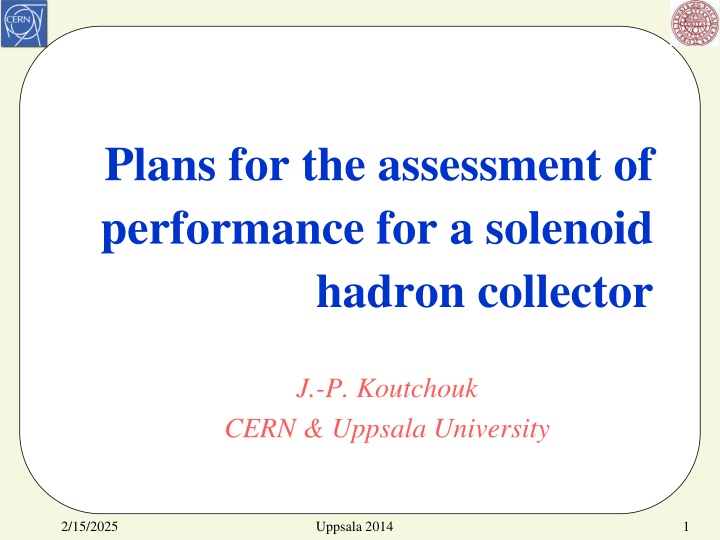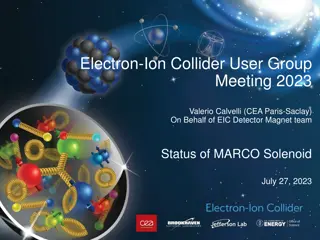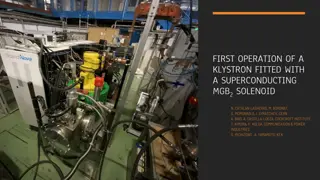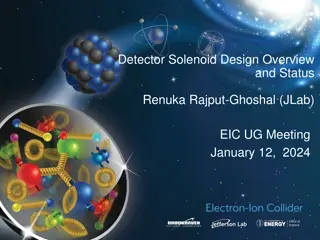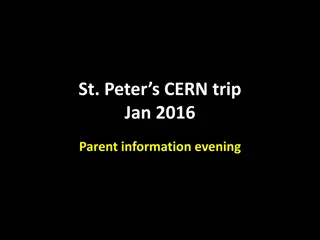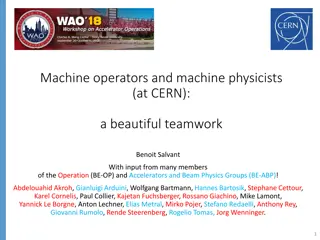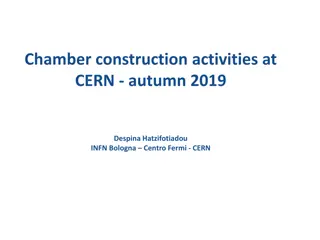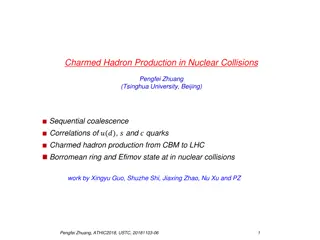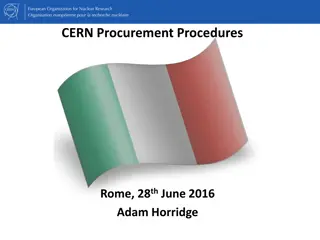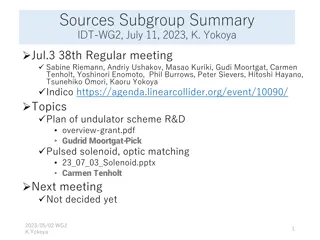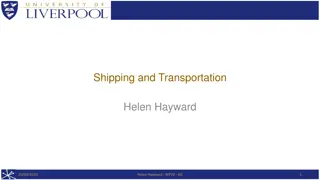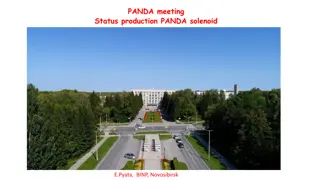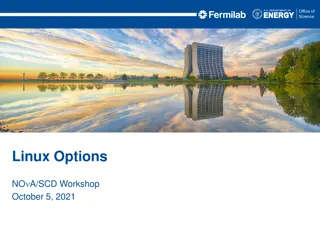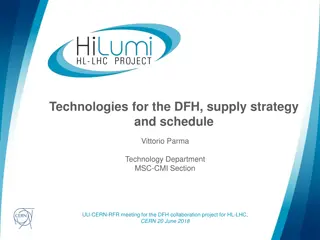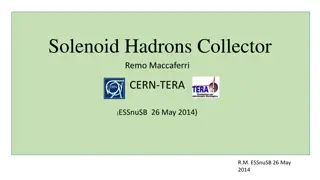Performance Assessment Plans for Solenoid Hadron Collector J.-P. Koutchouk CERN & Uppsala University
This document outlines former work and desired plans for the assessment of performance in a solenoid hadron collector, focusing on technologies available today. It references past studies, prospective research, and scenarios for experiments at CERN, providing insights into the advancement of solenoidal systems for hadron collection.
Download Presentation

Please find below an Image/Link to download the presentation.
The content on the website is provided AS IS for your information and personal use only. It may not be sold, licensed, or shared on other websites without obtaining consent from the author.If you encounter any issues during the download, it is possible that the publisher has removed the file from their server.
You are allowed to download the files provided on this website for personal or commercial use, subject to the condition that they are used lawfully. All files are the property of their respective owners.
The content on the website is provided AS IS for your information and personal use only. It may not be sold, licensed, or shared on other websites without obtaining consent from the author.
E N D
Presentation Transcript
Plans for the assessment of performance for a solenoid hadron collector J.-P. Koutchouk CERN & Uppsala University 2/15/2025 Uppsala 2014 1
Outline 1. Former work 2. What technology can offer today 3. Desirable work plan 2/15/2025 Uppsala 2014 2
1- Former work Blue: more recent ref. summarized; black: identified but not yet analyzed 1983: positron sources for LAL (Chehab) 1985: positron sources for SLAC (Bulos et al.) 1999: Angular collection using solenoids (Chehab, Nufact99) 1999: a solenoidal capture system for production, (Diwan et al. BNL, PAC99). 1999: Prospective study of muon storage rings at CERN (Autin, Blondel, Ellis, CERN) 2000: Optimum optical systems for future accelerators, (R. Royer CERN) 2002: A scenario for a BNL nu SB experiment (Diwan et al, BNL & Princeton) 2003: A nu horn based on a solenoid lens (McDonald, Princeton) 2006: Solenoid vs horn focus for neutrinos, (R.B. Palmer, BNL) 2006: Comparison of solenoid and horn focusing, (S. Kahn, Muons Inc.) 2008: horn and solenoid options, (M. Yoshida, NuFact08) 2/15/2025 Uppsala 2014 3
Prospective study of muon storage rings at CERN (1) Edited by B. Autin, A. Blondel & J. Ellis CERN 99-02, ECFA 99-197, 30 April 1999 Step 1: 1-2 GeV proton linac, beam power ~ 20 MW, high-field solenoid for pion and muon collection; prospects for CP violation studies marginal. The design and even construction of this line of machines could involve capabilities that are available in different laboratories in Europe. A dedicated collaboration involving EU laboratories is necessary in order to go further, and could become extremely effective Uppsala 2014 2/15/2025 4
Prospective study of muon storage rings at CERN (2) hadron collection by a solenoidal system (p5) : Quarter wave transformer where the field varies stepwise between 2 solenoids [R. Chehab, positron source, LAL/RT92- 17] Adiabatic device with exponential field decay 20T needed Section 2.3 solenoids for pion collection, J. Collot and W. Joss Hybrid magnet: the warm coil protects the cold one. Uppsala 2014 2/15/2025 5
A scenario for a BNL nu SB experiment (1) Diwan, Kahn, Palmer, Parsa, Stumer BNL, McDonald, Princeton Ref: 2002. Magnetized detector assumed (0.5T) 20T solenoid for capture with field dropping from 20T to 2.5 T in 10 m to provide focusing; sol radius is 15 cm at target; capture up to 450 MeV (similar to Neutrino factory, S. Ozaki et al., nu fact feasibility study II report, Tech.Rep. BNL (2001)-52623. Uppsala 2014 2/15/2025 6
A scenario for a NL nu SB experiment (2) Uppsala 2014 2/15/2025 7
A Nu horn based on a solenoid lens (1) McDonald, Princeton Ref: Note, 2003 Tutorial on solenoid horns: point to parallel for cumb of pion energies, depends on B field and solenoid length: particles must complete an odd number of half turns before entering the fringe field. Uppsala 2014 2/15/2025 8
A Nu horn based on a solenoid lens (2) Uppsala 2014 2/15/2025 9
Optimum optical systems for future accelerators P. Royer, CERN Ref: CERN PS seminar, 9th Nov. 2000. Study of a system Capture solenoid + matching solenoid for a neutrino factory: - Adiabatic capture with field dropping from 20T to 1 T B0/(1+az) - Matching solenoid (or quads) - Study carried out using a symbolic optics code Uppsala 2014 2/15/2025 10
Solenoid vs horn focus for Nus R.B. Palmer, BNL Ref: seminar at Princeton, Aug 27 2006 Adiabatic capture with B=20T down 2T in 2 m and down to .2T over 100 m. solenoid radius 7.5 cm. Comparison with 5 horn solutions. Preliminary conclusions: Solenoid may be superior at low momenta Solenoid could be improved if larger bore affordable Horn could be reoptimized at low momenta Uppsala 2014 2/15/2025 11
Comparison of solenoid vs horn focus (1) S. Kahn, Muons Inc., USA Ref: seminar at Princeton, Jul 27 2006 Adiabatic capture with B=20T down 1.6T in 20 m. solenoid bore radius 7.5 cm. If only and not is desired, then a dipole magnet could be inserted between adjacent solenoids above. Uppsala 2014 2/15/2025 12
Comparison of Horn and Solenoid Focused Beams (2) The Figure shows the spectra at 0 at 1 km from the target. Solenoid Focused Beam. Two Horned Focused Beam designed for E889. So-called Perfect Focused beam where every particle leaving the target goes in the forward direction. The perfect beam is not attainable. It is used to evaluate efficiencies. A solenoid focused beam selects a lower energy neutrino spectrum than the horn beam. This may be preferable for CP violation physics Similar results at 1.5 deg.off axis S. Kahn -- Comparison of Solenoid and Horn July 27, 2006 13
Comparison of solenoid vs horn focus (3) Conclusions (for 12 GeV protons/ AGS) Most of this work had been done on and off between 1999 and 2001. We had appreciated that making long solenoid channels would be an effective way to hold pions until they decayed. We were concerned about the cost of these long solenoid channels since horns were relatively cheap. We were not successful keeping the beam focused after we left the solenoid (??). Horns were reasonably efficient in capturing pions particularly the high part of the spectrum. There was not much room for enormous gain. This talk should provide an introduction into Harold Kirk s talk which discusses more recent work that has been done on this subject. S. Kahn -- Comparison of Solenoid and Horn July 27, 2006 14
Horn and solenoid options in Nu factories M. Yoshida, Osaka Univ. Ref: presentation at NuFact08 Adiabatic capture with B=6T down 1.T in 2.5 m. 50% of pion decay at 5 m . solenoid bore radius 7.5 cm. Uppsala 2014 2/15/2025 15
My tentative conclusions of the former work analyzed the solenoid capture has been considered for positron sources and neutrino factories; nothing for SB s except good words (possibility of separating species with a dipole inside solenoid slices). In all cases, adiabatic capture by a decaying solenoidal field is considered, assuming NbTi technology and ~15 cm bore. Tracking seems to show that at 1 km, solenoid capture would be better than horn capture for ESSnuSB energies. For several 100 km s however, the quality of point to parallel optics does not seem to be studied hence neither demonstrated. Concern is expressed for extra cost while no drastic improvement of performance over horns is identified. Radiation resistance is to be studied. Uppsala 2014 2/15/2025 16
2- What technology can offer today Former studies ( done in the LHC time) assume a 20 Tesla superconducting solenoid based on the ATLAS/CMS, NbTi technology. Since then, under the impulse of ITER, medical applications, and the LHC upgrade studies, especially by USLARP, , the difficult Nb3Sn engineering is making rapid progress. Nb3Sn offers the possibility of higher fields or larger bores, and a somewhat larger temperature margin before quench. 2/15/2025 Uppsala 2014 17
Preliminary feasibility studies of a focusing solenoid for the ESSnuSB, R. Maccaferri, 6-03-2014 16 Tesla, 30 cm bore R. Maccaferri, CERN, TERA 2/15/2025 Uppsala 2014 18
16 Tesla, 30 cm bore Field calculation performed for a 2m long model, both without and with magnetic return. R. Maccaferri 2/15/2025 Uppsala 2014 19
3- Work Plan (not resource-loaded ) 1. Classical solenoidal focusing: Revisit classical solenoidal focusing, including its aberrations. The focusing is a subtle effect of the solenoid edges. Hence it is quite important to master it well when the final aim is to suppress one edge! The potential of solenoids is so far from usual colliders that the knowledge is probably confined to scientists working on sources. 2. Charge separation: Understand whether, in this classical case, tilting the solenoid or adding a dipole between two solenoid slices produces the charge separation that is wanted. 2/15/2025 Uppsala 2014 20
3. Moving the source inside the solenoid: Investigate the optics when the source is inside the solenoid, both for focusing and charge separation. This is of major impact, as one of the edges will be missing. My understanding is that the system will become monochromatic. Good or bad? 4. Optimizing the solenoid: What is the real gain of an adiabatic capture vs a standard solenoid? Worth the complexity? 5. Performance estimate for ESSnuSB: With a provisional layout, using the solenoid devised by R. Maccaferri, track the pions and compare at the detector with the baseline horn, and optimize the layout for maximum yield (within an energy band?) 6. Cooling and radiation: Investigate the energy deposition and activation of the solenoid coil. Can it be protected by internal shielding liners? 2/15/2025 Uppsala 2014 21
